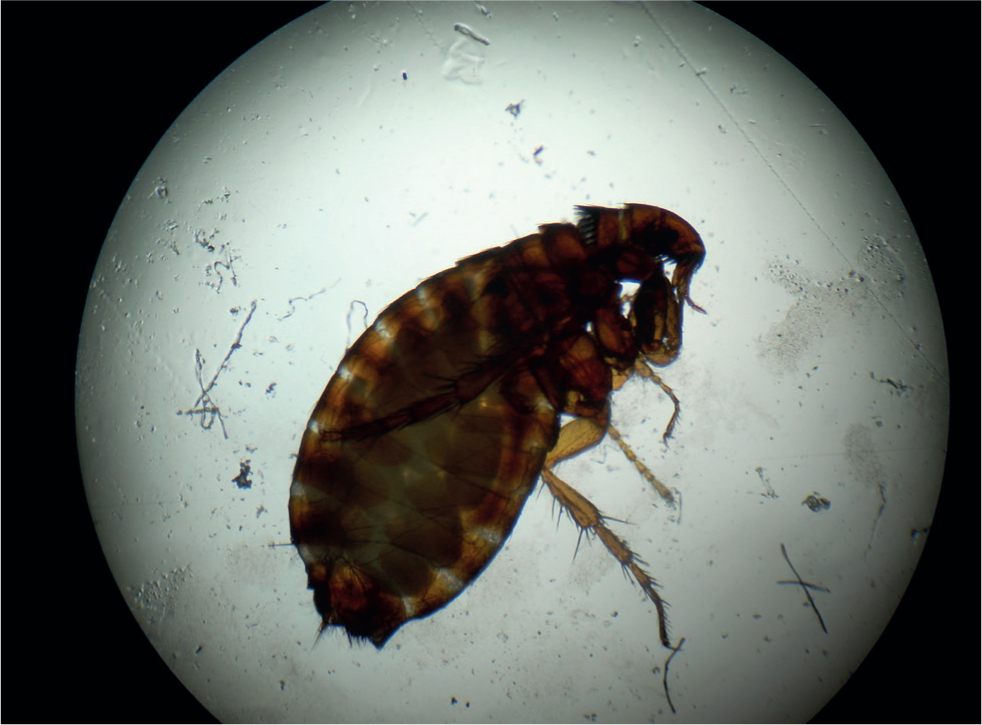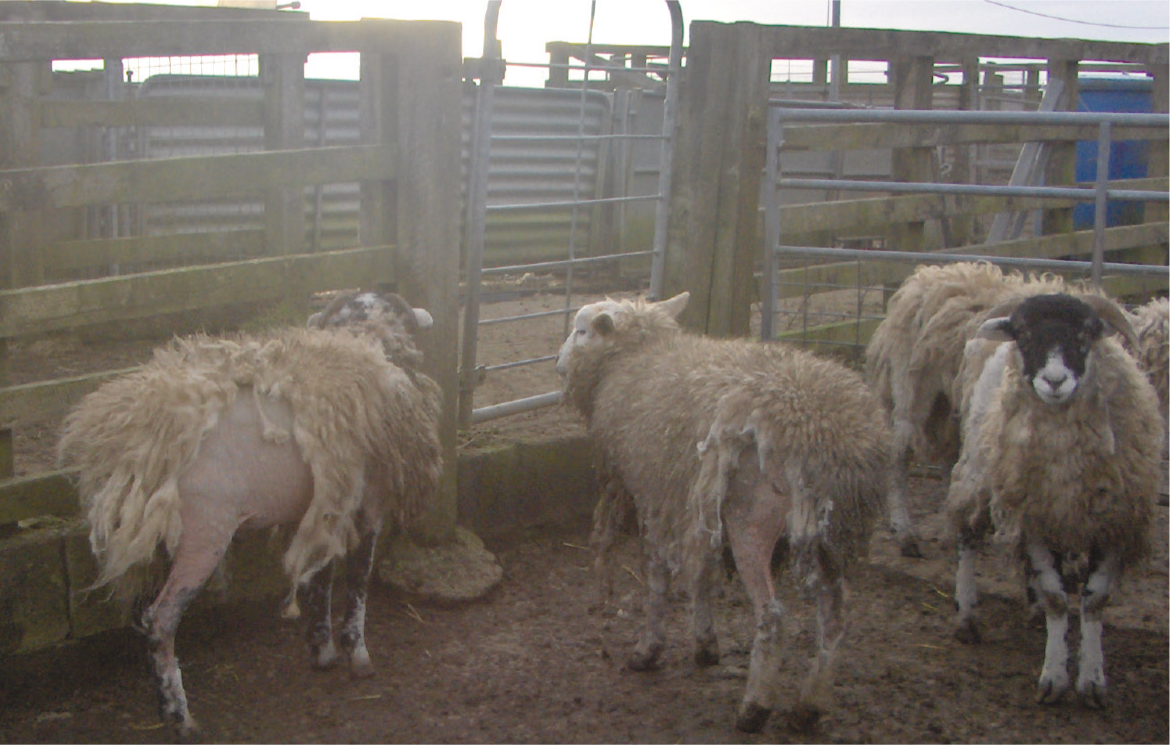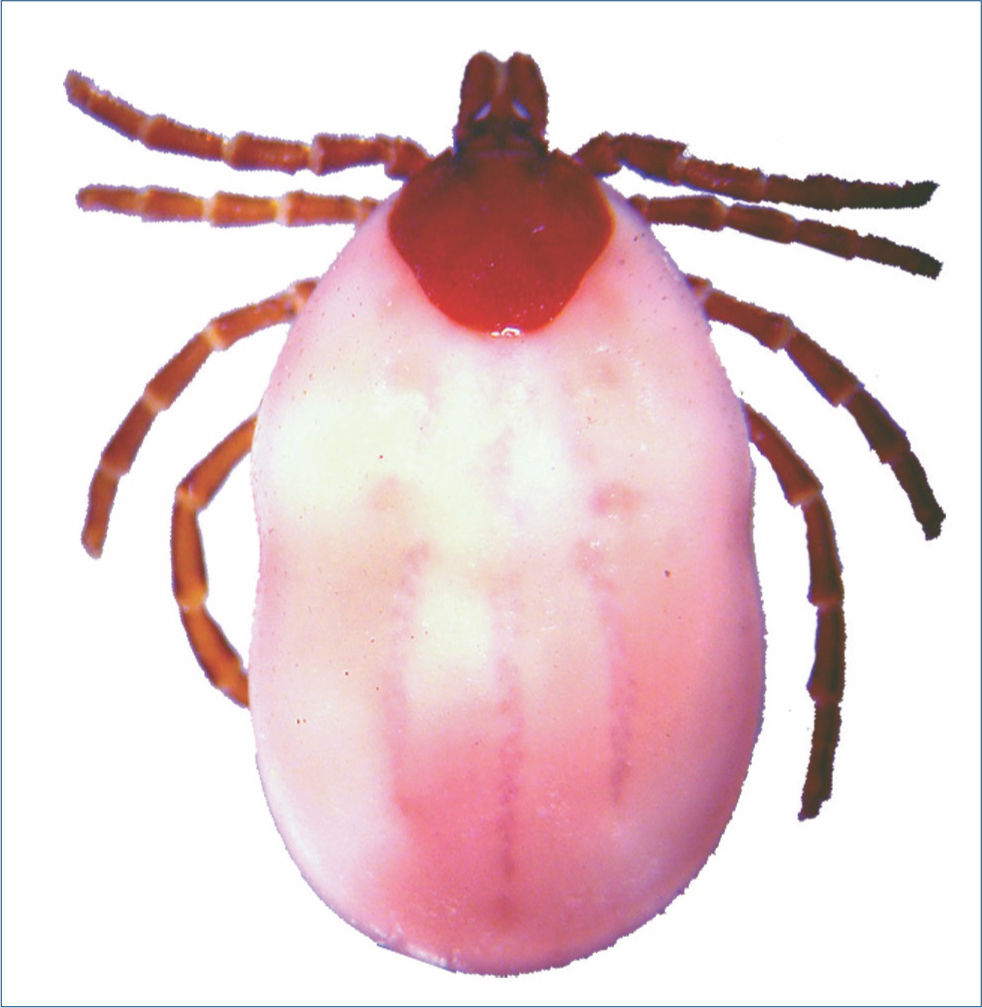Ectoparasites in sheep are a major concern worldwide, as they represent a significant constraint to global food security (Fitzpatrick 2013), through their negative impact on welfare and production, mainly through wool, meat and milk production losses, plus a negative effect on fertility and lamb growth rates. Their chemical treatment and control also account for major costs, with a significant impact on the environment.
There is a long list of ectoparasites that can affect sheep, some have major economic and welfare implications, others are more relevant in specific geographical location or in relation to the system of production (Colebrook and Wall, 2004; Cortinas and Jones, 2006).
The main ectoparasites (in alphabetical order) for sheep are:
- Fleas (Ctenocephalides felis) — heavy infestation of cat flea can cause anaemia in lambs (Figure 1)
- Flies — bottle fly (Calliphora spp. and Lucilla sericata), which causes blowfly strike; nasal blot fly (Oestrus ovis), which causes parasitic rhinitis; and head fly (Hydrotea irritans), which causes lesions around the horns in young sheep and rams
- Keds (Melanophagus ovinus) — cause annoyance, pruritus and wool loss and, in cases of severe infestation, anaemia, as they are blood-suckling wingless fly
- Lice — these are divided into sucking/blood feeders (Lignonathus ovillus and pedalis) and chewing/biting (Bovicola ovis)
- Midges (Culicoides) — they can represent a great nuisance for animals, sometimes also causing insect bite hypersensitivity. They are mainly important, however, as a vector of diseases, such as bluetongue virus (BTV) and Schmallenberg virus (SBV).
- Mites — these are the cause of different types of mange — sheep scab (Psoroptes ovis), chorioptic mange (Chorioptes ovis), demodectic mange (Demodex ovis) and sarcoptic mange (Sarcoptes scabei var. ovis)
- Ticks (Ixodes ricinus, Dermacentor marginatus, Rhipicephalus spp. and Haemophysalis punctata) — they can cause anaemia in lambs, however, they are more important as a vector of diseases.

Main ectoparasite-related diseases in the UK
Among all the listed diseases that are related to ectoparasites, some are particularly relevant in the UK. To find out which diseases are common in a particular area, the surveillance tool developed by Animal and Plant Health Agency (APHA) can be used (https://public.tableau.com/app/profile/siu.apha/viz/SheepDashboard_/Over-view). The tool indicates the main diagnoses in a particular area. As per autumn 2021, the most diagnosed ectoparasitic diseases across all ages in the UK were: sheep scab; pediculosis; tick-borne disease; and blowfly strike.
Sheep scab
Sheep scab is the most important ectoparasitic disease of sheep in the UK and it is a notifiable disease in Scotland (Busin, 2018). It is an allergic dermatitis caused by the host specific, non-burrowing ectoparasitic mite P. ovis (Figure 2). The main sources of the disease are infested neighbouring farms, purchased or returning animals, common grazing and shared equipment. There is intense inflammatory reaction, with clinical signs of marked pruritus, self-trauma, severe dermatitis, alopecia and considerable weight loss. Lesions are localised initially around the shoulders, extending progressively to the lumbar area and flanks. Diagnosis of sheep scab can be achieved through identification of mites in skin scrapings (most suitable for advance clinical cases), or through detection of antibodies specific to a mite allergen (Pso o 2) via serum indirect enzyme-linked immunosorbent assay (ELISA). The main differential diagnoses for sheep scab are pediculosis, other forms of mange and dermatophilosis. Fleece-rot, ringworm, midge allergy, photosensitisation and scrapie should also be considered.

Pediculosis
Pediculosis is an ectoparasitic disease caused by lice, which are highly host-specific obligate parasites. The chewing/biting louse (B. ovis) can survive for a very short period off the host, making indirect contact transmission highly unlikely. The sucking/blood feeder lice (Linognathus ovillus and pedalis), instead, can survive up to 20 days off the host, however transmission still happens mainly through close contact with infected animals (Colebrook and Wall, 2004; Cortinas and Jones, 2006). Lice do not tolerate high rainfall or exposure (for example through shearing) and high temperatures, with optimal conditions for their survival and replication at housing (long fleece and dry environment). In most cases, there is slow infestation because of the low percentage of eggs hatching, with long periods (months) for heavy infestation to develop. Pediculosis is often asymptomatic, however lice can cause irritation with pruritus, excoriation and self-wounding, fleece damage and loss. Chewing lice tend to spread all over the body, but mainly on the back, while sucking lice typically affect the face and legs, with development of anaemia if there is severe infestation. Diagnosis of pediculosis is achieved by visual inspection of the fleece and by direct microscopy of hair samples, demonstrating the presence of lice. The main differential diagnosis is sheep scab, followed by cutaneous myiasis, scrapie, and chorioptic mange.
Tick-borne diseases
Ticks are commonly found in unimproved, upland or hill areas, with dense matted vegetation and mostly in spring and summer (peak activity is generally in April–July and occasionally in autumn). As a result of the change in climate temperature, however, an extended tick season has now been documented, with data from the Tick Surveillance Scheme suggesting tick exposure can now occur at any time of the year (Public Health England (PHE), 2021). Ticks feed for a relatively short period on the host and spend most of their life in the environment. The most common tick found in the UK is I. ricinus (Figure 3), which has a three host cycle, with a blood feed at each stage (larva, nymph and adult).

In the UK, three tick-borne diseases are particularly important:
- Louping ill, or ovine encephalomyelitis — this is an acute non-contagious meningoencephalitis, caused by the louping ill virus, an RNA virus of the genus Flavivirus. Ticks acquire the infection from blood of infected animals, with the virus localising in the salivary glands and infecting a new host at the following meal. In sheep, the virus proliferates in the regional lymph nodes, producing viraemia, and then localises in the central nervous system. The disease is commonly seen in naïve animals introduced in endemic areas, in lambs older than 3 months (when colostrum immunity starts to decrease), and in yearlings (older sheep tend to have acquired immunity). The main clinical signs are neurological signs: depression; ataxia (high-stepping gait especially in the hind limbs); seizures; muscle tremors; circling and paralysis, leading to death within few days. Diagnosis in the live animal can be reached through serology or virus isolation (polymerase chain reaction (PCR)). At post-mortem examination, there are no gross lesions, but histopathology of the brain is characteristic (non-suppurative meningoencephalitis with perivascular accumulation of mononuclear cells). Differential diagnoses include swayback, cerebrocortical necrosis (CCN), spinal cord lesion, tetanus and visna. There is no treatment, and the disease is managed through vaccination and by effective tick control. Of importance, louping ill is a zoonotic disease, causing mostly flu-like symptoms, usually through occupational exposure (mainly for stockmen, abattoir workers, veterinarians and laboratory scientists).
- Tickborne fever — this is an immunosuppressive disease, caused by the bacteria Anaplasma phagocytophilum, an obligate intracellular rickettsial organism. Ticks acquire infection by feeding from persistently infected animals, with the organism localising in the gut. In sheep, the bacteria infect the white blood cells (mainly neutrophils), which are then destroyed, producing profound leukopenia (neutropenia, lymphopenia and thrombocytopenia). Naïve animals introduced in endemic areas are the ones at risk, as lambs are usually infested within the first 2 weeks of life, showing milder symptoms than older lambs. Clinical signs include high fever (>40°C), which can persist for up to 3–6 days, anorexia, dullness and abortion in pregnant sheep or infertility in rams. Because of the significant immunosuppression effect, tick-borne fever is mostly important as it can lead to other important diseases, like pasteurellosis, tick pyaemia, listeriosis and louping ill (Aitken, 2007). Diagnosis can be reached through microscopic smear examination (inclusion bodies within the neutrophils), serology or virus isolation (PCR), while the most significant change at post-mortem examination is an enlarged spleen. Oxytetracyclines can be used for the treatment of acute febrile cases, but control is achieved mainly with the reduction of tick infestations and from controlled exposure and development of immunity during low-risk (outside breeding) periods.
- Tick pyaemia — this is a superinfection of lambs with staphylococcal bacteria (mainly Staphylococcus aureus), introduced when the lamb is bitten by the tick. The disease is often a consequence of A. phagocytophilum infection, inducing pyaemic abscesses throughout the body, but mainly in the joints (Aitken, 2007). Lambs are most commonly affected at 2–12 weeks old, with clinical signs depending on the localisation of the abscesses. Treatment with penicillin or tetracycline antibiotics can be effective in some cases, but control of the disease is, again, achieved through effective control of ticks (Colebrook and Wall, 2004; Cortinas and Jones, 2006).
Blowfly strike
Blowfly strike is also called cutaneous myiasis and it is caused by the infestation of living tissues with the fly larvae of the genus Lucilia. Flies are attracted by decaying animal tissues, infected or necrotic injuries and soiled wool. They lay eggs in these areas, which hatch within 12 hours, and maggots feed on the tissue for 3 to 10 days, before dropping off to become mature flies (Aitken, 2007). It is a seasonal disease, with high-risk period between May and September. As with ticks, however, the changing climate has extended the seasonal activity of flies, with the potential for fly strike happening later than expected. In mild cases, maggots do not cause clinical disease and lesions heal quickly and completely. Strike happens when high number of maggots feed on the host, releasing toxin from decomposing tissue and causing toxaemia and eventually death. Clinical signs include separation from the flock, pruritus, restlessness, discoloration of the wool and unpleasant smell (Aitken, 2007). Diagnosis is achieved by visual inspection, and prompt treatment (application of insecticide coupled with shearing of the affected areas) is of paramount importance to avoid further suffering. Chemical control should be implemented in high-risk areas or during high-risk periods, coupled with animal husbandry practices, such as shearing, reduction of faecal soiling and prompt management of skin injuries.
Treatment and control of ectoparasites in sheep
Treatment and control of ectoparasites in sheep have traditionally focused on the use of chemicals (Table 1). The choice of chemicals and the application methods depend on many factors, most importantly the ectoparasite(s) involved, but also consideration of flock size, labour and facilities available, withdrawal periods and whether the aim is for control or eradication. In the case of many of the chemicals used, there are also concerns related to the operator safety and the environmental impact. Most importantly, there is also growing evidence of resistance to many of the chemicals (Sturgess-Osborne et al, 2019).
Table 1. Available chemicals for the treatment and control of ectoparasites in sheep
| Compound | Plunge dip | Shower dip | Pour-on | Spot-on | Injectables |
|---|---|---|---|---|---|
| OP | ScabBlowfly strikeHeadflyLiceTicksKeds | Blowfly strikeChorioptic mange | / | / | / |
| SP | Blowfly strikeHeadflyLiceTicksKeds | Blowfly strikeChorioptic mange | Blowfly strikeHeadflyBiting liceTicks | Blowfly strike | / |
| IGR | / | / | Blowfly strike | / | / |
| ML | / | / | / | / | ScabSucking liceKeds |
OP = organophosphate — diazinon; SP = synthetic pyrethroid — cypermethrin, deltamethrin and alphacypermethrin; IGR = insect growth regulator — cyromazine and dicyclanil; ML = macrocyclic lactones — doramectin, ivermectin, moxidectin
For ectoparasites that complete their lifecycle on the host and will only survive for a short time in the environment (e.g. P. ovis), eradication from the flock should be possible if effective treatments have been applied (for example organophosphate are not effective when used in jets or showers for the control of P. ovis), followed by good management and biosecurity methods. For ectoparasites that normally live in the environment (e.g. ticks and flies), control can be achieved by managing exposure to the parasite, and identifying the correct timing for treatment. Other means of controls, that do not rely on chemicals, can also be implemented. These include control of scouring, tail docking and use of fly traps.
Looking at the future
Vaccines
One of the first vaccines to become available against ectoparasites of livestock is the recombinant vaccine against the cattle tick Boophilus microplus. Since the vaccine became available, research has focused on developing vaccines against all the ectoparasites that have the most significant effects on the host (ticks, mites and flies). The basis for the development of an effective vaccine is linked to the response of the host after repeated infestation. First of all, if there is an acquired immunological response, will this be protective to reinfestation? And if that is the case, is such a response replicable with vaccination? For example, in the case of blowfly, sheep do react to infestation with a strong immunological response, however, there is no reduction in larval growth. In the case of sheep scab, there is evidence of reduction in lesion size and mite numbers, when animals are re-infested after the primary infestation has been treated, with a recombinant subunit vaccine already showing promising results (Burgess et al, 2016).
Biotechnologies
Biotechnology-enhanced sterile insect technique approaches have recently made some important advances, which could be applicable to ectoparasite control. For example, RNA interference (RNAi) affords protection by silencing mRNA, resulting in the suppression of critical gene functions. Other possibilities include lethal gene technology and gene editing using clustered regularly interspaced short palindromic repeats (CRISPR), which relies on the insertion of a selected DNA sequence into the genome of the male. Once introduced into the population all offspring inherit the altered gene sequence, and within a few generations the population becomes dominated by the transgene constructs, eliminating or neutralising the population (Pérez de León et al, 2020).
Genetic resistance
Breeding for resistance has been identified as a powerful tool to aid the control of livestock diseases, as it significantly reduces the need for therapeutics, while maintaining a high standard of health and welfare. However, it can be a very slow process, requires intense monitoring and sometimes comes at a production cost. Generally, the simplest solution is to cull (or avoid breeding) those animals that appear to be most affected by a particular disease. In the case of ectoparasites, phenotypic selection of traits that could be used to select indirectly for resistance, like breech wrinkles, breech wool coverage and wool characteristics, have already been identified for blowfly strike (Bishop and Morris, 2007). Recently, more emphasis has been put on genetic markers of resistance. These are based on specific genes or DNA sequences that can be used to identify resistant or susceptible animals independently of infection. As understanding of the host-parasite interaction improves and the technologies for whole genome sequencing are becoming available, this could really represent the future of disease control.
Conclusions
Ectoparasites are clearly a significant issue for livestock production, with a negative impact on health, welfare and economics. Although different treatment and control options exist and our understanding of the biology of these parasites has improved, some diseases are unfortunately still very common in the UK sheep industry. Recognition of these diseases and knowledge of the options available to effectively control them is of paramount importance to reduce their burden and contribute to the overall sustainability of sheep production.
KEY POINTS
- The main ectoparasites (in alphabetical order) for sheep are: fleas, flies, keds, lice, midges, mites and ticks.
- The main ectoparasite-related diseases in the UK are sheep scab, pediculosis, tick-borne diseases and blowfly strike.
- The main chemicals available for treatment and control of ectoparasites in sheep are organophospate, synthetic pyrethroid, insect growth regulator and macrocyclic lactones.
- Recent research has brought promising results in the field of vaccine development, biotechnologies and genetic resistance, which could improve control of ectoparasites for livestock.


